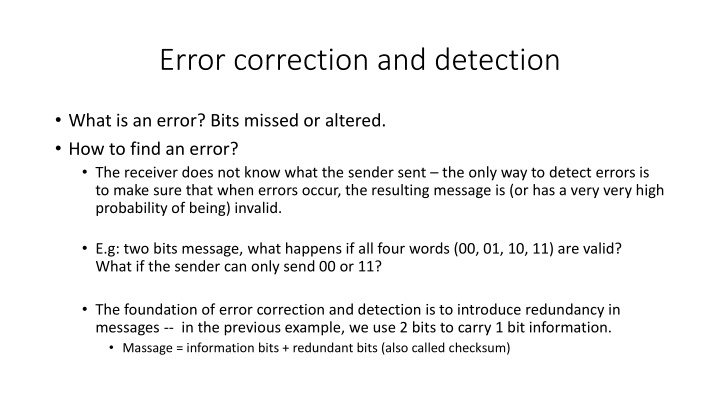
Error Correction and Detection in Communication Systems
Learn about the concepts of error correction and detection, the role of redundancy in messages, general approaches to designing error-correcting codes, Hamming distance calculations, error detection and correction capabilities, and the importance of redundant bits in error correction codes.
Download Presentation

Please find below an Image/Link to download the presentation.
The content on the website is provided AS IS for your information and personal use only. It may not be sold, licensed, or shared on other websites without obtaining consent from the author. If you encounter any issues during the download, it is possible that the publisher has removed the file from their server.
You are allowed to download the files provided on this website for personal or commercial use, subject to the condition that they are used lawfully. All files are the property of their respective owners.
The content on the website is provided AS IS for your information and personal use only. It may not be sold, licensed, or shared on other websites without obtaining consent from the author.
E N D
Presentation Transcript
Error correction and detection What is an error? Bits missed or altered. How to find an error? The receiver does not know what the sender sent the only way to detect errors is to make sure that when errors occur, the resulting message is (or has a very very high probability of being) invalid. E.g: two bits message, what happens if all four words (00, 01, 10, 11) are valid? What if the sender can only send 00 or 11? The foundation of error correction and detection is to introduce redundancy in messages -- in the previous example, we use 2 bits to carry 1 bit information. Massage = information bits + redundant bits (also called checksum)
General approaches of error correction and detection How to design codes that have error correction and detection capability? To detection n-bit errors, we must make sure that after n-bit are altered in a message, the resulting message is invalid (something that sender will never send). To be able to correct n-bit errors, we must make sure that for a valid message, for each of the 1 to n bits altercations, the resulting message must have no overlap with other valid messages as well as the potential n-bit errors from any other valid message. We need to have a way to measure the spacing between valid messages (which are sometimes called valid codewords all possible messages that the sender can send): Hamming distance
Hamming distance Hamming distance between two codewords: how many bits need to be changed in order for a codeword to become the other. The number of different bits between two codewords E.g. What is the hamming distance between 010101 and 111000? Let a code be the set of all valid codewords. Hamming distance of a code is the minimum Hamming distance between any of the two codewords in the code. Example: What is the Hamming distance of Code {010101, 111000, 000111, 111111}?
Hamming distance and the error detection/correction capability Let the Hamming distance of a code be N. How many bits of errors can be detected? How many bits of errors can be corrected? Given code {00000000, 00001111, 11110000, 11111111}. Compute the Hamming distance. How many bits of errors can be detected? How many bits of errors can be corrected? What is Hamming distance of the Even parity code?
Error correction code How many (r) redundant bits do we need to correct a single error for the m information bits? A message contains m+r bits total number of possible codewords: 2m+r total number of valid codewords = 2m To correct single error, each single error must results in a different (invalid) codeword. Total number of (invalid) codewords for one bit error = (m+r)2m total number of valid codewords plus the total number of (invalid) codewords for single bit error must be less than the total number of possible codewords. 2m+(m+r)2m<= 2m+r m+r+1 <= 2r
Error correction code How many (r) redundant bits do we need to correct single error for the m information bits? m+r+1 <= 2r m = 1, r = 2 m = 2, r = 3 m = 3, r = 3 m = 1000, r = 10 This formula gives the lower bound of the redundant bits to correct a single error. Hamming code achieves this lower bound (Chapter 3.2.1) How many redundant bits are needed to detect a single error?
Error control Two options Use error correction code Use error detection code with retransmission Which option is better? Intuition? Example: assume an error rate of 10-6 . Each packet carries 1000 bits information. The system will only have single bit errors. Quantitatively compare the two options. From the example, can you derive when should error correction code be used, and when should error detection code with retransmission be used?
Error detection code Parity code: detect single bit error In communication system, this is not good enough. We must be able to detect more errors. The most commonly used error detection code is called polynomial code or cyclic redundancy code (CRC code)
CRC code How it works: A bit stream is treated as a polynomial with coefficients 0s and 1s A k bits data corresponds to a k-terms polynomial and vice versa 11001 ?4+ ?3+ 0?2+ 0?1+ ?0 The sender and the receiver both have a same generator polynomial G(x) with degree r (r is the number of redundant bits). Sender: adds r checksum bits to the information bits to make sure that the message is divisible by G(x). Receiver: receives the information and checksum bits, do the division and make sure that the received message is divisible by G(x). If yes, valid message, otherwise, error detected. The error detection capability depends on the selection of G(x).
How does the sender compute the checksum? Example: 10 bits data: 1101011011, 4 bits checksum Generator 10011 Let r=4 be the degree of G(x). Append r=4 0 s to the low-order end of the 10 data bits so that the frame contains m+r bits corresponding to ?(?) ?? 1101011011 0000 Using modulo 2 division to divide the bit stream corresponding to ?(?) ??by the bit stream string corresponding to G(x) (10011 in this example). Add the reminder back to the frame. What is the reminder, what is the final data frame for this example.
How does the receiver check to see if a received frame has error? Divide the data frame 1101011011 1110 by the generator 10011 Divisible: no error Not divisible: error
Exercise Generator: 1001 Data: 10000011 What is the data frame to be sent? Received 1101100. Is this a valid packet?
Power of the CRC code Depending on the selection of G(x) Let T(x) be the frame polynomial, E(x) be the error polynomial and G(x) be the generator polynomial We want to make sure that when E(x) is not zero, (T(x) + E(x)) / G(x) = E(x)/G(x) is not zero. Detect single bit error E(x) = xj: if G(x) has more than two terms, guarantee to detect all single bit errors Detect two errors: E(x) = xj+xk=xk(xj-k+1): xk+1 (k<32768) cannot be divisable by x15+x14+1 Detect odd numbers of errors: no polynomial with an odd number of terms has x+1 as a fac
CRC code use case Ethernet generator polynomial (CRC-32) x32+x26+x23+x22+x16+x12+x11+x10+x8+x7+x5+x4+x2+x1+1 Detects all bursts of 32 bits or less, all bursts affecting an odd number of bits, etc. Hamming distance of 4.

